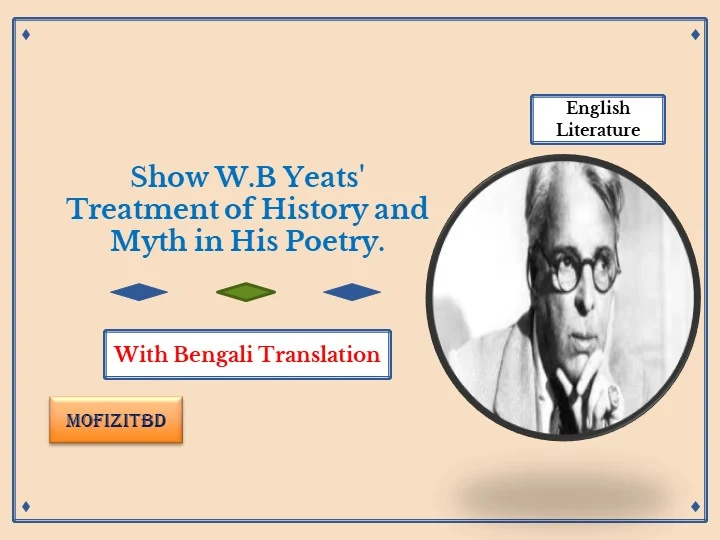Show Yeats' Treatment of History and Myth in His Poetry.

Yeats was greatly enthused by the charm of myth and used it in numerous poems to reveal his complex philosophical understandings. Yeats was keen to replace traditional Greek and Roman mythological figures with figures from Irish folk lore.
The juxtaposition of the Greek and the Irish myths, and his enthusiasm for old and modern philosophy has distinguished his poems from his contemporaries. The following discussion hinges round Yeats' handling of myth, philosophy, and history along with a critical inquiry into some of his major poems.
Sailing to Byzantium reveals Yeats use myth and philosophical understanding. In the poem Byzantium symbolises some transcendental country, a place out of time and nature, a world of art and philosophy. Here the poet rejects the natural world of biological activity and decides to take refuge in the timeless world of art with a view to retreat from the process of ageing and decaying.
The poem is a transition from sensual art to intellectual art. The poet feels that an old man is disgraceful unless his soul can enjoy works of art and literature which are immortal products of the human spirit. The weaker a man grows in body, the greater should be his joy in the works of art. Appreciation of art and understanding of art can be achieved only by studying magnificent and immortal works of art, the poet decided to go to
Byzantium to devote himself to the study of its treasures. Yeats often uses geometrical symbols of cone or gyre to express his quasi- mystical philosophy of historical change. The concept considers that the process of history is a cyclic one which repeats itself in different appearances. History like an individual passes through different phases along with gyres. Each phase covers a rise, growth and decline of civilization.
The end of an age occurs when disintegration begins at the circumference of the gyres and an antithetical gyre is born. In the poem The Second Coming the poet describes the current historical moment in terms of his concept of gyre. Yeats opines that the present wheel of history has come to full circle and out of its ruin a new age in human history seemed to be taking birth. He envisions that mankind is moving from a period of Christianity to Paganism. So rebirth of paganism is the cyclical process of history.
Easter 1916 deals with the contemporary political history of Ireland. The poem is a reaction to the Irish insurgence in 1916. In this poem Yeats gives an account of some of the insurgents who were personally known to him. Yeats tells that all these acquaintances were the members of this same comic world and played their own roles here.
But now they have resigned from their roles, since they are deceased. Their heroic sacrifice transformed them utterly. But what is ultimately born out of this eternal transformation is a kind of terrible beauty, since this beauty can only provide us with the picture of a number of graves. These people's hearts were united by having one purpose alone.
They are all deceased and beyond recall. But still, to hinder the life's natural course they have taken refuge permanently inside the hearts of every Irishman like a stone. Time passes, huge changes take place in nature, but still no changes occur around this stone. In the midst of all living activity it stays like a great burden. The insurgence that they made proved an utter failure but still these martyrs owe us an admiration for their self- sacrifice, since their intention was noble.
To sum up, W. B. Yeats by skillfully blending myth with history has developed a philosophy or vision of life which is quite modern. Out of the ancient myth he created poems which reveal the historical and philosophical issues of the past, present and future.

